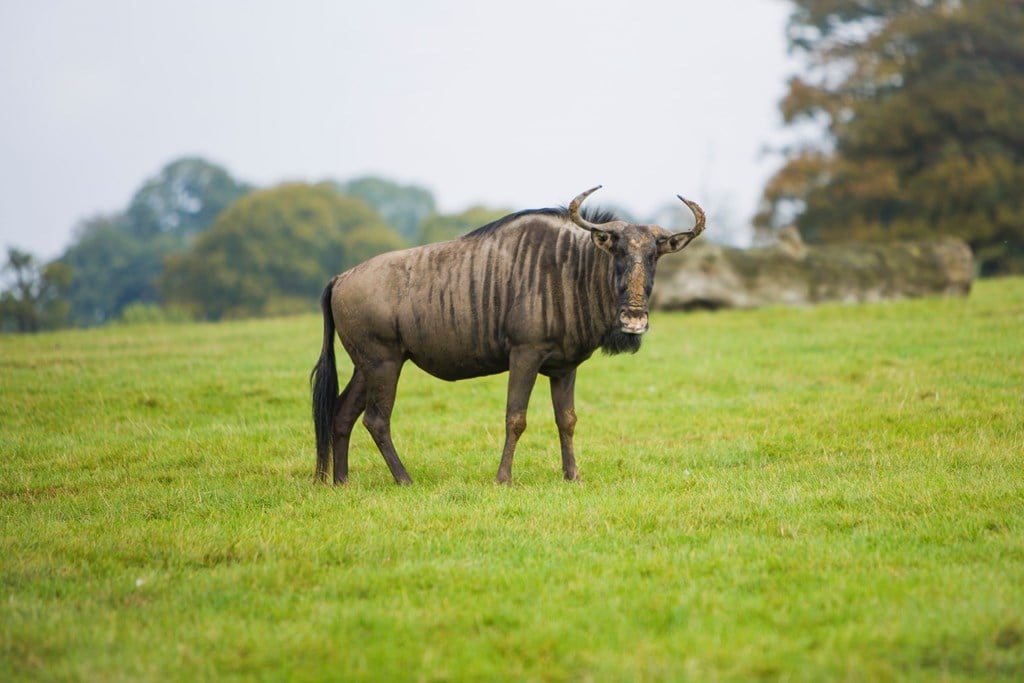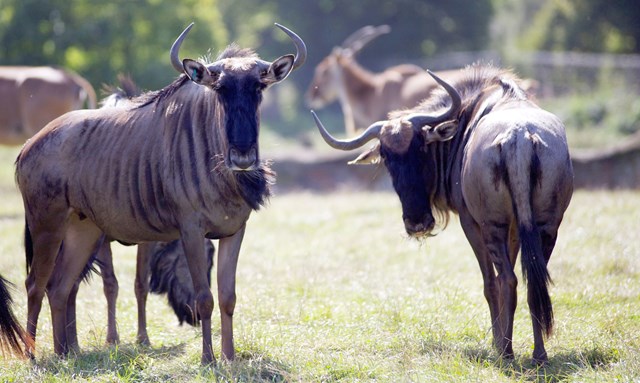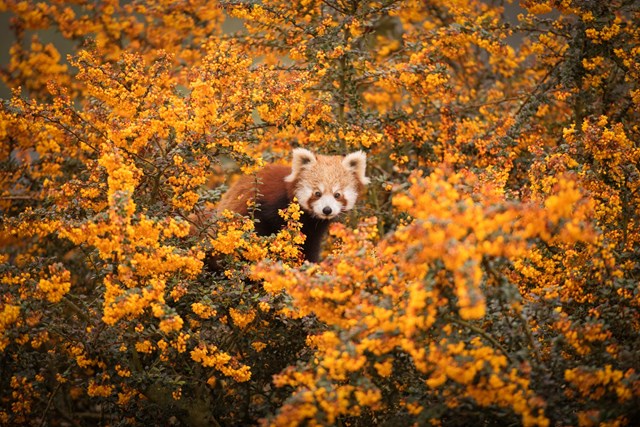Overview
The brindled wildebeest is a large antelope and is one of two species of wildebeest.
The herd of brindled wildebeest at Woburn Safari Park can be seen as you approach the stone lions at the entrance to the main Road Safari.

All about us
| Distribution: | Central and Southern Africa |
|---|---|
| Habitat: | Plains, savannah, bush and woodland |
| Height: | 1.5m at the shoulder |
| Weight: | Up to 290 kg |
| Gestation Period: | 8 - 8.5 months |
| Lifespan: | Captivity: around 20 years |
| Threats: | Poaching, predation by carnivores |
About Us
Scientific name: Connochaetes taurinus
Brindled Wildebeest are extremely agile and when alarmed they will paw at the ground and prance around waving their tails. If they feel threatened they will run away, occasionally stopping to look back.

The brindled wildebeest is a grazer and has a broad mouth which is adapted to bulk feed on short grass. Its dependence on short grass together with the need to drink at least every other day means they need to follow seasonal grazing and water supplies by seasonally migrating.
Some wildebeest will take up a permanent residence within their habitat and these small populations usually consist of around 8 cows and their calves however, the vast majority of Wildebeest are permanently nomadic meaning that they have no fixed home range. This seasonal movement can vary from year to year depending on the amount of food available and the rainfall that has occurred that year. This seasonal migration is a survival strategy which allows the effective use of resources over larger areas and minimises over-utilisation. It is not known why some small populations within the same region and conditions remain resident whilst so many others are nomadic.
They have a loose social structure as the only stable associations are between females and their offspring. Dominant bulls are solitary maintaining territories when the herd is sedentary. The boundaries of these territories are marked with dung heaps and the pawing of the earth. Only males with a territory may breed with the females and competition between males is comprised of displays, loud grunting calls and shoving with their horns. Brindled Wildebeest are extremely agile and when alarmed they will paw at the ground and prance around waving their tails. If they feel threatened they will run away occasionally stopping to look back.
Wildebeest have a very restricted breeding season and calves are born within a two to three week period at the start of the rainy season. After an 8 to 8.5 month gestation a single calf is born and able to run with the herd just minutes after birth remaining very close to its mother at all times. By nine months of age the calves are weaned and by the age of 12 months all of the young males are pushed out of the herd by territorial males. They will then join a bachelor herd until they reach sexual maturity and will then live a solitary life until they are able to establish their own territory.
The colouration in the adults coat can vary from a bluish grey to a brown grey. They have dark vertical stripes on their neck and forequarters that look like wrinkles in the skin from a distance. Both the males and females grow short curved horns extend out to the side and then curve up and inwards. They can grow between 30 to 40 cm in females but up to 83cm in males. They have a slight hump above their shoulders with a sloping body towards the rear. They have large heads with the front of their face covered in black hair. They also have a long black mane, a long black tail and both sexes have a black beard of hair hanging from their throat.
Threats to the species include the spread of human settlement, livestock and agriculture as human habitation leads to less grassland which threatens the long term numbers of the Wildebeest. They are poached for meat and are often the victims of predation by lions, spotted hyena, Cape hunting dog, leopard, and cheetah. They are also easy prey for crocodile as they lean down to drink from waterholes on a regular basis.
Brindled wildebeest are often at their most active in the morning and late afternoon so that they can spend the middle of the day when the temperature is at its highest resting.
Wildebeest love rolling in sand and dirt and at Woburn they are often digging big holes in the ground with their front legs and then rolling in the freshly dug up earth!
When possible they will drink twice daily at their nearby watering hole.
The wildebeest at Woburn can be very lively and will run laps of their 26 acre exhibit jumping over logs and disturbing all the other animals as they go!
The migration of the wildebeest is famous in Africa as almost a million will make the 400 km journey from their wet season range on the open plains to their dry season refuge in the woodlands.

